公示语汉英翻译
- 格式:pptx
- 大小:2.81 MB
- 文档页数:19
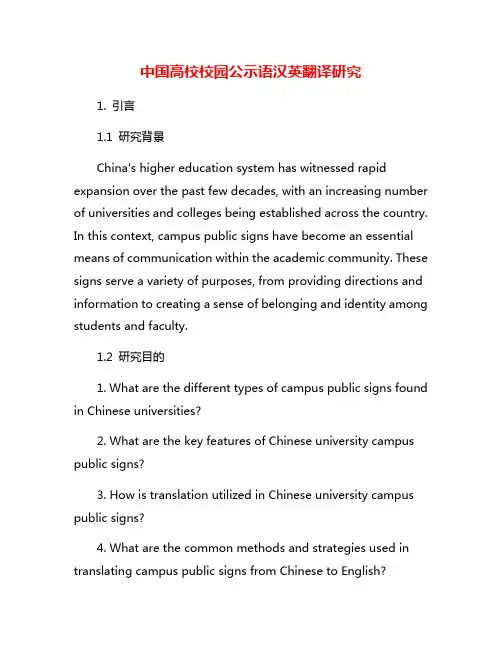
中国高校校园公示语汉英翻译研究1. 引言1.1 研究背景China's higher education system has witnessed rapid expansion over the past few decades, with an increasing number of universities and colleges being established across the country. In this context, campus public signs have become an essential means of communication within the academic community. These signs serve a variety of purposes, from providing directions and information to creating a sense of belonging and identity among students and faculty.1.2 研究目的1. What are the different types of campus public signs found in Chinese universities?2. What are the key features of Chinese university campus public signs?3. How is translation utilized in Chinese university campus public signs?4. What are the common methods and strategies used in translating campus public signs from Chinese to English?5. How do international students and visitors perceive the translated campus public signs?6. What are the implications of this research for improving the quality of translation in Chinese university campus public signs?7. What are the potential future research directions in the field of translating campus public signs in Chinese universities?2. 正文2.1 校园公示语的定义和分类校园公示语是指在高校校园内用于传达信息、提醒注意事项或指引方向的语言文字形式,通常以标语、警示语等形式呈现。
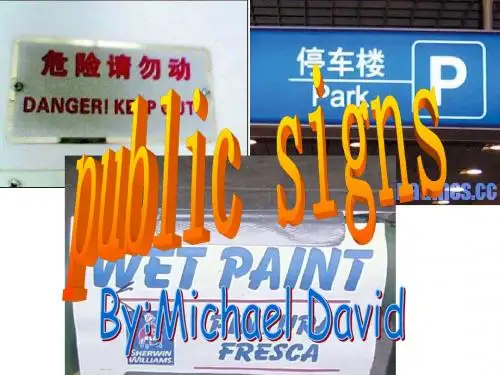
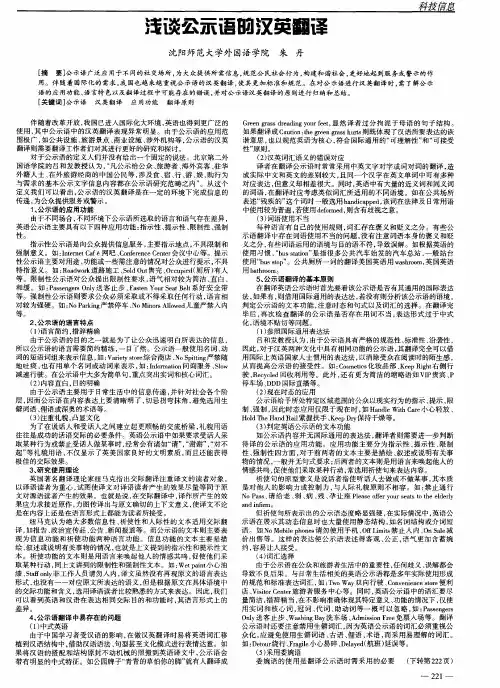

、公示语的汉英翻译原则1.“静态”与“动态”结合公示语在使用中的功能不同,所展示的信息状态也不同,既有“静态”,也有“动态”。
“静态”意义的公示语是指广泛应用于旅游设施、旅游景点、旅游服务、商业设施、体育设施、文化设施、卫生设施、宗教会所、科教机构、涉外机构、街区名称、旅游信息咨询中心等方面的突出服务、指示功能的公示语。
公示语大量应用名词,直接、准确无误显示特定信息。
如:新鲜果蔬Fresh Produce、票务处理Ticket Problems、网吧Internet Caf、吸烟席Smoking Seat、会议中心CONFERENCE CENTER、餐饮部FOOD & BEVERAGE、商务中心BUSINESS CENTER、经理DIRECTOR、正在施工ROADWORK、海关THE CUSTOMS、注册登记REGISTRATION等。
“动态”意义的公示语是指广泛应用于公共交通、公共设施、紧急救援等方面,更多使用展现“动态”意义的语汇表达提示、限制、强制功能的公示语。
将公众的注意力集中在公示语发出者要求采取的行动上。
如:向右转弯Turn Right;严禁拍照No Photographing;谢绝小费No Tipping;仅限紧急情况下使用Emergency Use Only等。
“静态”公示语与“动态”公示语在特定语境中的有机结合,恰当摆布,可以满足公众、旅游对信息的需求,有效提高生存和消费的质量。
2.使用常见词汇(common words)英语公示用语的词汇选择应考虑到广大公众和旅游者的文化水平,尽量避免生僻词语、古语、俚语和术语。
如:请勿乱扔废弃物No Littering;有人Occupied(厕所);绕行Detour;小心易碎Fragile;专用车位Private Parking等。
由于公示语在公众和旅游者生活中的重要意义,任何歧义、误解都会导致不同后果。
与日常生活相关的英语公示语都是多年实际使用形成的约定俗成的语汇。
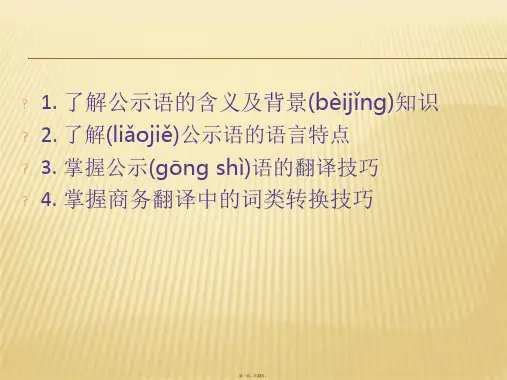
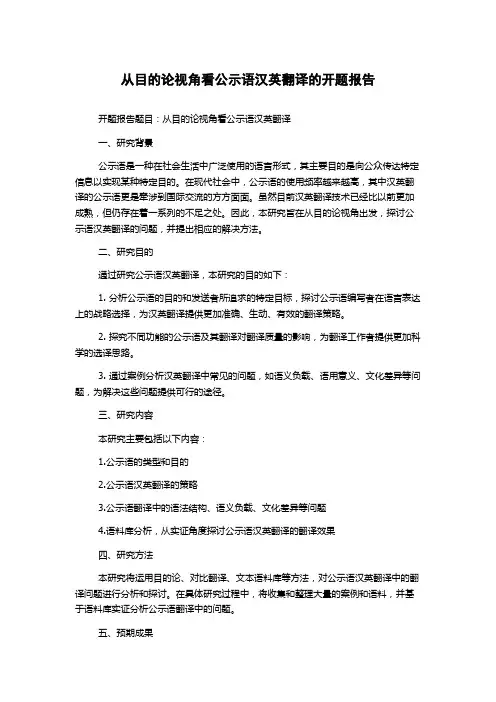
从目的论视角看公示语汉英翻译的开题报告开题报告题目:从目的论视角看公示语汉英翻译一、研究背景公示语是一种在社会生活中广泛使用的语言形式,其主要目的是向公众传达特定信息以实现某种特定目的。
在现代社会中,公示语的使用频率越来越高,其中汉英翻译的公示语更是牵涉到国际交流的方方面面。
虽然目前汉英翻译技术已经比以前更加成熟,但仍存在着一系列的不足之处。
因此,本研究旨在从目的论视角出发,探讨公示语汉英翻译的问题,并提出相应的解决方法。
二、研究目的通过研究公示语汉英翻译,本研究的目的如下:1. 分析公示语的目的和发送者所追求的特定目标,探讨公示语编写者在语言表达上的战略选择,为汉英翻译提供更加准确、生动、有效的翻译策略。
2. 探究不同功能的公示语及其翻译对翻译质量的影响,为翻译工作者提供更加科学的选译思路。
3. 通过案例分析汉英翻译中常见的问题,如语义负载、语用意义、文化差异等问题,为解决这些问题提供可行的途径。
三、研究内容本研究主要包括以下内容:1.公示语的类型和目的2.公示语汉英翻译的策略3.公示语翻译中的语法结构、语义负载、文化差异等问题4.语料库分析,从实证角度探讨公示语汉英翻译的翻译效果四、研究方法本研究将运用目的论、对比翻译、文本语料库等方法,对公示语汉英翻译中的翻译问题进行分析和探讨。
在具体研究过程中,将收集和整理大量的案例和语料,并基于语料库实证分析公示语翻译中的问题。
五、预期成果通过本研究,预期能够解决公示语汉英翻译中的难点问题,为汉英翻译工作者提供更加有效的翻译策略和技巧。
同时,还能够为公示语的编写者提供精准的信息传递方式,并在跨文化交流中保持信息的准确性和通达性。
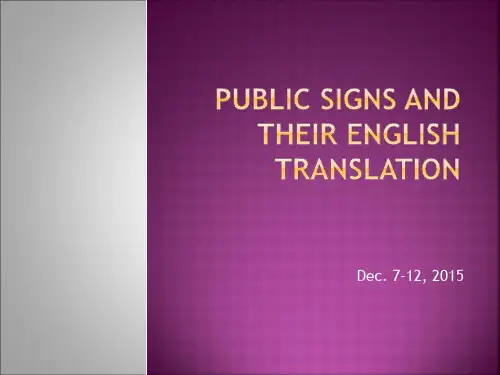
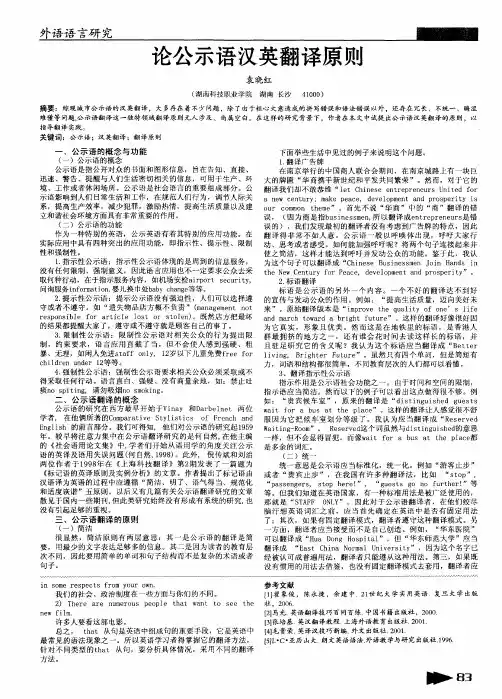
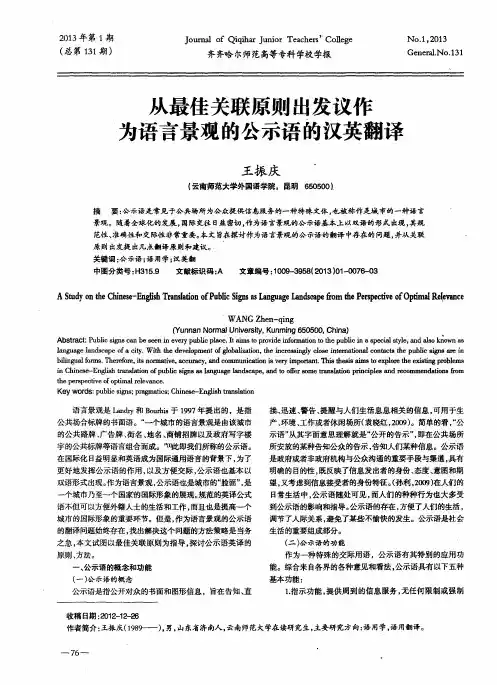
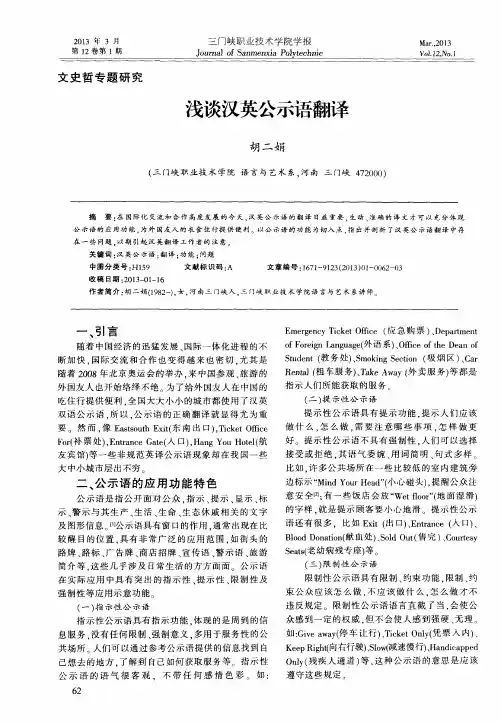
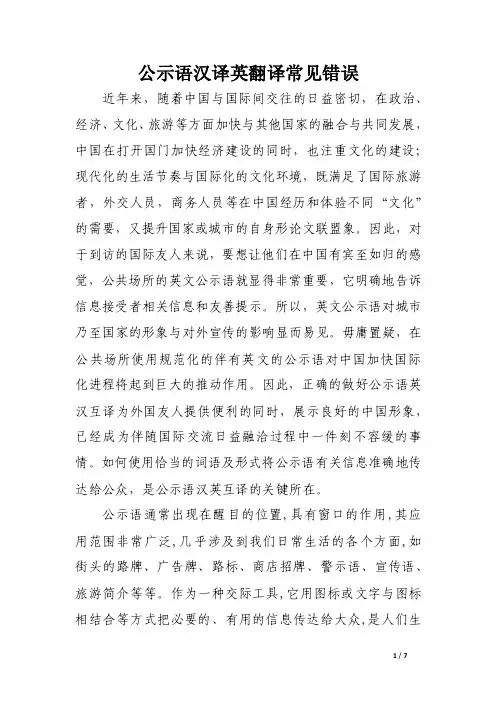
公示语汉译英翻译常见错误近年来,随着中国与国际间交往的日益密切,在政治、经济、文化、旅游等方面加快与其他国家的融合与共同发展,中国在打开国门加快经济建设的同时,也注重文化的建设;现代化的生活节奏与国际化的文化环境,既满足了国际旅游者,外交人员,商务人员等在中国经历和体验不同“文化”的需要,又提升国家或城市的自身形论文联盟象。
因此,对于到访的国际友人来说,要想让他们在中国有宾至如归的感觉,公共场所的英文公示语就显得非常重要,它明确地告诉信息接受者相关信息和友善提示。
所以,英文公示语对城市乃至国家的形象与对外宣传的影响显而易见。
毋庸臵疑,在公共场所使用规范化的伴有英文的公示语对中国加快国际化进程将起到巨大的推动作用。
因此,正确的做好公示语英汉互译为外国友人提供便利的同时,展示良好的中国形象,已经成为伴随国际交流日益融洽过程中一件刻不容缓的事情。
如何使用恰当的词语及形式将公示语有关信息准确地传达给公众,是公示语汉英互译的关键所在。
公示语通常出现在醒目的位臵,具有窗口的作用,其应用范围非常广泛,几乎涉及到我们日常生活的各个方面,如街头的路牌、广告牌、路标、商店招牌、警示语、宣传语、旅游简介等等。
作为一种交际工具,它用图标或文字与图标相结合等方式把必要的、有用的信息传达给大众,是人们生活中不可或缺的帮手。
作为一种特定功能的文本形式,公示语应用历史久远,对其翻译研究意义深远。
在世界各民族的社会、文化、经济发展进程中,准确的公示语翻译对外籍人员来说,具有良好交际效果,可有效地对其规范社会行为,提高生产效率以及优化生存质量等方面。
由于公示语在传递信息中的语言特色和特殊功能,我们应该认清公示语翻译过程中可能出现的问题及背后的原因。
将极大地有助于翻译人员采取正确的翻译方法和翻译策略来解决问题。
要想解决以上问题,我们首先要了解公示语翻译研究趋势。
公示语的翻译研究在国外有比较长的发展历史,现在已经较为成熟和规范;而在中国,针对公示语方面的汉英翻译研究起步较晚,翻译界对此展开的研究还很不够,缺乏体系性和规范性。
公示语的汉英翻译摘要:随着经济全球化,中国正在经历巨大的变化。
英语已然成为全世界最流行的语言之一,因此双语的实施是不可避免的。
因为公示语的作用在于给人以信息,它是一个城市的面貌的重要组成部分。
而且它也是生活中最实用的语言,蕴涵了中国特有的文化。
为了构建现代化的大都市,必须注重进程中的每个细节,而公示语的翻译就是其中比较突出的一个。
本文从公示语的定义及重要性入手,分析了公示语汉英翻译中常见的质量问题,探讨了公示语的语言特点和公示语翻译应当遵循的原则,并对译者提出要求。
关键词:汉英翻译;公示语;Contents1.Introduction (1)1.1 A Brief Introduction of the Translation of Public Signs (1)1.2 The Definition of Public Signs (1)2.The Present Situation of the Translation of the Public Signs (2)2.1 Information Lost and Tampered (2)2.2 Words Improperly Used (4)2.3 Problem in Spelling and Pronunciations (5)2.4 Translation Disunified (6)2.5 Unsuitable Translation (7)3.Methods to Assess the Quality of Translation of Public Signs (8)3.1 From the Aspect of the Applied and Indicated Function (8)3.1.1 Informational Function (8)3.1.2 Instructive Function (8)3.1.3 Regulatory Function (8)3.1.4 Warning Function (9)3.2 According to the Standard Issued by the State (10)3.3 Taking the Traditional Translation into Consideration (11)4.Methods Employed in Public Signs Translation (12)4.1 Literal Translation (12)4.2 Semantic Translation (13)4.3 Adaptation (14)5.Some Recommendations (15)6.Conclusion (17)1. Introduction1.1 A Brief Introduction of the Translation of Public SignsThe errors in C-E sign translation have drawn much attention of the public and the experts in this field. As a result, academic research and public campaigns on C-E sign translation are prevailing now. With the first national seminar on translation of public sings being held by the China Translation Association on the International Translation Day in 2005, the translation of public signs has been on the agenda of the construction of a modernization China. On the seminar, experts on the translation of public signs, points out that, the use of language in a country implicates the culture of that nation; on the process of constructing a harmonious society, all kinds of improper use of our mother tongue and foreign languages is inharmonic with that theme.A lot of errors were found and have been put into process, changed or unified, however, it is even until now—two years after the first nation seminar, the situation is not so positive. The translation of public signs is still far from perfect, even in world-famous metropolis as Beijing and Shanghai. This not only gives a negative impression on our foreign friends, but also is baneful to the development of our economy and culture and the gradually increase of foreign-oriented communication. 1.2 The Definition of Public SignsAccording to Oxford English Dictionary, sign refers to a characteristic device attached to, or placed infront of,an inn or a store,as a means of distinguishing it from others or direct attention to it.Public signs include marker, pointer, guide post, catchline, pronunciamento, warning and so on. Sometimes it is also called the environmental communication notices and signs (Ding Hengqi, 2006).The Chinese name of public places mainly refers to name of certain places and public places, such as public service establishments, public cultural and sports places, tourist scenic spots, national exhibitions and large activities, the office for the national department and so on (Xu Jian,2006) .While in English, there are many classifications for public signs and each of themwith a special name. For example, public signs in public buildings are called environmental communication signages, which mainly refer to the way-finding directional signs (Ding Hengqi, 2006). The signs in sight-seeing spots are certainly an important aspect of the public signs and they belong to environmental communication. The informational instructions on foods, medicine, cosmetics are also one kind of public signs, the instructional notices. English has a really long history for bilingual or multilingual public signs study, so it has been developed in a complete way, while in China, in such a short time, we can not make thorough development. The Chinese public signs are somehow different from their English counterparts and have their own characteristics.2. The Present Situation of the Translation of the Public SignsThough we have carried out the policy of reform and opening up to the outside world for many years, the history of bilingual public signs is of certain limitation. Some cities adopt the double language of public signs in the purpose of giving convenience and connecting China with the world. Each city has their own kinds of translation and then uses it in a rather proud way of being the first group of cities walking before the big tide of double-language.However, for various kinds of reasons, the status quo of the translation of the public signs is not so positive.As media takes part in, more versions of translations have come out, unfortunately without unification. While concerning this problem, it can be divided into several classifications as following:2.1 Information Lost and TamperedInformation lost and tampered is a big problem in the translation of public signs. To explain this category, some specific examples are illustrated. Please look at the following examples:Example A: “Passengers, stop here.”“Guests go no further.”“Guests, stop here.”“Tourists stop here.”From the translation of public signs above, as Chinese, we have no difficulty in guessing the meaning this sign wants to express originally. That is “Staff Only”(LuHefa & Shan Lipin, 2004) in English and “游客止步”in Chinese. All the text of the translation mentioned above is quoted from some tourist spots. It is no doubt that such series of translation will actually cause more or less misunderstanding and raise discussion. Many of them adopt the literal translation skills and put it in a rather stiff way. And one of the big problems is that it neglects the culture: this public signs already have their counterparts in English. As to such a matter, it is better to use the relative and idiomatic way to express it.Example B: “Shanghai Swimming Pool” , “Shanghai Swimming Center” and “Shanghai Swimming Gym”, which is better for the translation of “上海游泳馆”?“Pool” usually means:(1) a small and rather deep body of usually fresh water;(2) a quiet place in a stream;(3) a body of water forming above a dam (Webster’s Dictionary).“Center”here is given the meaning of a group of the same things that come together and combined to a big one.While gym is the abbreviation of gymnasium:(1) a large room used for various indoor sports (as basketball or boxing) andusually equipped with gymnastic apparatus;(2) a building (as on a college campus) containing space and equipment forvarious indoor sports activities and usually including spectator accommodations, locker and shower rooms, offices, classrooms, and a swimming pool (Websters’) .It seems that all these words can be combined with “swimming”, but the meaning is different. “Swimming pool”usually refers to one pool and it is used to describe those outdoor ones; while “swimming center” often takes up the center of that place and is the biggest one and sometimes even the unique one in that area. “Swimming gym”is comparatively common and it is more sports-oriented and always inside a building.As a matter of fact, the “上海游泳馆” contains more than one swimming pool andis a building with roof. It is also equipped with many training devices with the special training course carried out daily. Seen from the explanations mentioned above, the “上海游泳馆” actually should be translated into “Shanghai Swimming Gym”.This category of mistakes usually results in the misunderstanding or semi-understanding of the word and the culture of English. Like Chinese, English is full of synonyms. Though they are similar with each other in meaning, they are still different under certain circumstance, expressing the different meaning. Small differences should be paid great attention to, otherwise, mistake will occur and information be lost or tampered.2.2 Words Improperly UsedAll the translation context are translated by translators or interpreters, while their acquired English is of various levels, so the translation will no wonder fall into various category. The improper use of words is unavoidable. And we can see this kind of mistake in many places.The most common one is the translation of the residence of a community. In China, people tend to use “**花园,**新村,**村”to describe a residence of a group of people. For example, the translation of “美政花园”is “Meizheng Garden”on the guidepost along Fuxing Road in Hangzhou. Here “花园” indicates the place for living. But what is “Garden”to English-speakers? According to Merriam-Webster on line dictionary, the explanation is as following:(1)a: a plot of ground where herbs, fruits, flowers, or vegetables arecultivatedb: a rich well-cultivated regionc : a container (as a window box) planted with usually a variety of smallplants(2) a: a public recreation area or park usually ornamented with plants and treesb: an open-air eating or drinking placec: a large hall for public entertainment(Webster’s)To conclude, “Garden”is a place with plants and is created for relaxation and entertainment. So when English-speakers see the guidepost and go into the “garden”with the purpose of having some scenery to view or some relax, but only to find some tall buildings disappointedly and embarrassedly.Another example is the “市北新工业区”. The translation is “Shibei Industry New Zone”. When seeing this translation, we will wonder where “Shibei” is. It’s no doubt that this will cause a big laugh when we see the Chinese. Beside, this translation has another problem: the translation seems to be very coherence with the Chinese letter, even the order of the word. Actually it’s wrong. According to the usage of English word, the adjective “New” should be put above all other adjectives (Bao Bing, 2002). Therefore, the right translation should be “Shanghai Northern New Industry Zone”.2.3 Problem in Spelling and PronunciationsThe problem in spelling and pronunciation is very common in public sign translation. As we know, spelling and pronunciation is the most basic skills of English. But the translation of public signs in some places unfortunately manifests the qualification of the translator’s English. The spelling problem contains the mistake of followings:1) Wrong spelling“No smoking” and “No Park” is possibly due to the carelessness of the translator. The correct writing should be “ No Smoking” and “No Parking”.2) Capitalized wordsIn the display of place name, the capitalized words are used in a very common way. We can see every road on the guidepost begins with a capitalized letter. But unfortunately, many are wrongly written, especially on the screen of the public transportation in Shanghai. There’s a screen on every bus or subway that shows the name of the stop. And the mistake of capitalized mistake is unified in a surprising way—mistake all in one way, “South Hong Mei Road”, “Yan Chang Road”, “Gui Lin Newly State” and so on. According to the convention of translation of roads issued in 2005, name of roads should be written in a formal way, with the first letter of the proper noun(Xu Jian, 2006) capitalized and other using small letters. So the correct spelling should be “South Hongmei Road”, “Yanchang Road”and “Guilin Newly State” .3) PronunciationThe pronunciation of the transportation is newly appeared in the major cities of China. It is carried out to give convenience to English-speakers. But as a matter of fact, the pronunciations on buses or subways are not very clear, especially in Hangzhou, so it is not an easy work to understand them. Methods should be adopted to solve this problem.Besides, there’s another problem of pronunciation, using American English or British English. British English is standard English according to the history of English, however as centuries pass, American English now has become more popular and used more widely. So when announced in the bus or subway, the name of the bus stop should adopt which version of English is actually a difficult choice. .Further more, the pronunciation should be paid great attention to. In the Y5 bus in Hangzhou, it can be clearly noticed that the announcer pronounce the “r” as “l”. And intonation is a big problem as well.2.4 Translation DisunifiedThe disunification here refers to the translation of the same place or of the same place name in different way and the different translation of the same Chinese character with the same meaning.1) Same place name with different translation versionDifferent buses have different translation versions for the same bus stop, not even take that of the subway into consideration. For example, in Shanghai, there are many bus stops before “上海植物园”. While the author rides on different bus, two kinds of pronunciations are heard “Shanghai Botanic Garden”and “Shanghai A rboretum”. These two kinds of translation are all correct and suitable but there’s only one problem: the name place is unique when it refers to the specific ones. Try to imagine, if two foreigners talk about this place, one with the translation of “Shanghai Botanic Garden”, while the other uses another one. What an embarrassing situation it was.2) Same common noun with different translation versionHere the same common noun is the noun commonly used in place name, referring to things of the same kind and the special one of this kind, such as the “station”“airport” and so on (Xu Jian, 2006) . This kind of translation should be unified in the whole city, the whole country and even the world as a whole. While the author discover that this aspect of translation is really terrible to some extent. Take “新村” for example. In Hangzhou, the translation of “闸弄口新村”is “Zha Nong Kou Community ” but “田林新村” in Shanghai is “Tianlin Newly Estate”. “新村” is shown in the same characters and means the same in China, but why the translation of the two characters are totally different. This kind of translation should be put into unity and convention.3) Differences in writing and pronunciationThe author also discovers that some place are written in one way on the bus stop post and the digital screen in the bus, but announced in another way. For example, “田林十一村” in Shanghai is written “Tian Lin No.11 Newly State” while is broadcast in “11th Tianlin Newly State”. Though it is just a small problem and can be understood to some extent. Any way, this disunity should also be emphasized in the progress to contribute a perfect image of a civilized city.2.5 Unsuitable TranslationHere unsuitable translation refers to those that need translation are not translated and vice versa.Many public signs are not translated, like many public signs in the subway of Shanghai. Shanghai is a very common place for foreigners to go, visit or invest. And the subway is somehow a very important transportation means. “老,孕,病,残专座”should be translated out, “please offer this seat to elderly or disabled people or those carrying children”; “get off first” for “先下后上”; “get-on district” for “上客区” and “get-off district” for “下客区”.The expression of some public signs is very particular and exclusive in China. They illustrate the fascination or the dark aspect of China to which there’s no need to translate to show to our foreign counterparts (Luo Xuanmin & Li Tuwang, 2006). Take “No pee here” for an example. This public sign is embarrassed and only indicates the impoliteness of Chinese, which will leave a negative impression to those foreign visitors in the scenery spot. Therefore, it is better not to translate this kind of publicsigns.3. Methods to Assess the Quality of Translation of Public SignsThe author has pointed out several categories of mistake. So what is the standard the author takes to assess those translations? The standards are illustrated as the followings:3.1 From the Aspect of the Applied and Indicated FunctionAs the public signs is used in every aspect of our daily life and does direct impact on our life, the translation of public signs is based on the acknowledgement of the applied and indicated functions of them. The most important ones are informational function, instructive function, regulatory function and warning function (Stuart Redman, 2002). The different functions of the public signs directly affect the style and the mood of the translation.3.1.1 Informational FunctionInformational function refers to the service of the information, without any limited or compellent meaning. It is to provide some information to better the service towards the aimed group of people. Its function is to indicate the context of the service, for example: “Information”for “问询”, “Car Rental ” for “租车”, “Travel Service”for “旅游服务” and “Take away” for “外卖”。
公示语汉英翻译的问题及解决方案Contents摘要-----------------------------------------------------------------------------------------------------------ii 1. Introduction --------------------------------------------------------------------------------------------------1 1.1 Research Significance ----------------------------------------------------------------------------------11.2 Research Background -----------------------------------------------------------------------------------12. Literature Review ------------------------------------------------------------------------------------------23. The Classification of Public Signs --------------------------------------------------------------------43.1 Directive Public Signs --------------------------------------------------------------------------------43.2 Informational Public Signs --------------------------------------------------------------------------43.3 Restrictive Public Signs ------------------------------------------------------------------------------53.4 Mandatory Public Signs ------------------------------------------------------------------------------54. The Translation Problems of Public Signs ---------------------------------------------------------64.1 Linguistic Translation Errors ------------------------------------------------------------------------64.1.1 Misspelling ---------------------------------------------------------------------------------------64.1.2 Grammatical Errors -----------------------------------------------------------------------------74.1.3 Lexical Errors ------------------------------------------------------------------------------------74.2 Cultural Translation Errors --------------------------------------------------------------------------84.2.1 Unidiomatic Expressions -----------------------------------------------------------------------84.2.2 Poor Readability ---------------------------------------------------------------------------------94.2.3 Improper Tone ---------------------------------------------------------------------------------105.The Translation Solutions of Public Signs ---------------------------------------------------------105.1 Back Translation --------------------------------------------------------------------------------------105.2 Borrowing ----------------------------------------------------------------------------------------------115.3 Following International Standard ------------------------------------------------------------------125.4 Standardization ----------------------------------------------------------------------------------------135.5 Qualifying the Translators --------------------------------------------------------------------------136. Conclusion--------------------------------------------------------------------------------------------------14References --------------------------------------------------------------------------------------------------------iii Acknowledgements ----------------------------------------------------------------------------------------------v摘要公示语的英译是我国对外宣传及了解世界的窗口,公示语的翻译能否达到它本来的功能,不但影响到外国友人在中国的吃穿住用行,还关系到城市的精神面貌和整体形象,进而影响到我国的国际形象。
矿产资源开发利用方案编写内容要求及审查大纲
矿产资源开发利用方案编写内容要求及《矿产资源开发利用方案》审查大纲一、概述
㈠矿区位置、隶属关系和企业性质。
如为改扩建矿山, 应说明矿山现状、
特点及存在的主要问题。
㈡编制依据
(1简述项目前期工作进展情况及与有关方面对项目的意向性协议情况。
(2 列出开发利用方案编制所依据的主要基础性资料的名称。
如经储量管理部门认定的矿区地质勘探报告、选矿试验报告、加工利用试验报告、工程地质初评资料、矿区水文资料和供水资料等。
对改、扩建矿山应有生产实际资料, 如矿山总平面现状图、矿床开拓系统图、采场现状图和主要采选设备清单等。
二、矿产品需求现状和预测
㈠该矿产在国内需求情况和市场供应情况
1、矿产品现状及加工利用趋向。
2、国内近、远期的需求量及主要销向预测。
㈡产品价格分析
1、国内矿产品价格现状。
2、矿产品价格稳定性及变化趋势。
三、矿产资源概况
㈠矿区总体概况
1、矿区总体规划情况。
2、矿区矿产资源概况。
3、该设计与矿区总体开发的关系。
㈡该设计项目的资源概况
1、矿床地质及构造特征。
2、矿床开采技术条件及水文地质条件。
Science &Technology Vision 科技视界公示语在日常生活中应用非常广泛,旅游者所到之处,凡涉及食、宿、行、游、娱、购的处所都可以见到公示语。
公示语的应用直接影响到人们生活的方方面面,公示语满足的是旅游者、社会公众的社会、行为和心理需求,提供的是一种信息服务,在实际应用中具有指示性、提示性、限制性、强制性四种应用示意功能。
警示性公示语作为一种常见的公示语,主要起到提醒、示警公众对潜在危险的注意,它兼具提示性、限制性、强制性多种示意功能。
英语作为世界上使用最广泛的语言,其应用已涉及到社会生活的各个层面。
在日常生活中,我们看到的公示语往往以英文或中英结合的形式出现。
常用的警示性公示语多带有“Caution”、“Warning”、“Emergency”、“Danger”和“Beware”等字样,配合黄色几何图形标志出现在公共场合,以提醒公众及早预防潜在危险,避免不必要的财产或生命损失。
警示标志可以有不同的方式和不同的文字提醒,但在多数情况下,英语中警示性公示语的表达有一种约定俗成的方式。
故翻译此类公示语时,切不可望文生义,根据中国人的理解,翻译成不符合英语表达习惯的“中式英语”。
以下笔者将对带有“Caution”、“Warning”、“Emergency”、“Danger”和“Beware”字样的常用警示性公示语的英语翻译通过举例的方式作一番分析归纳。
1以“Caution”开头,表“当心、注意”的警示性公示语“Caution”的使用意在引起特定公众对这条信息的足够关注。
“Caution”的本意是“Taking care”,但是在警示性公示语中多见“Caution”,而罕见“Taking care”。
原因是“Taking care”和“Caution”使用的时机和地点都有差别,语气轻重亦不同。
“Caution”的使用说明“危险”就在眼前。
为此,在使用警示标志图形的同时,“Caution”这个词还要着重突出,字体大于危险具体内容的字号。